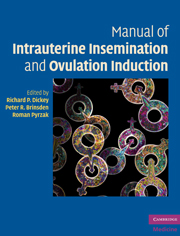Book contents
- Frontmatter
- Contents
- List of contributors
- Preface
- 1 An overview of intrauterine insemination and ovulation induction
- 2 Male causes of infertility: evaluation and treatment
- 3 Female causes of infertility: evaluation and treatment
- 4 Clinic and laboratory design, personnel and equipment
- 5 Semen analysis: semen requirements for intrauterine insemination
- 6 Semen preparation for intrauterine insemination
- 7 Ovulation induction for intrauterine insemination I: oral drugs clomiphene, tamoxifen, letrozole
- 8 Ovulation induction for intrauterine insemination II: gonadotropins and oral drug–gonadotropin combinations
- 9 Ultrasonography in the management of ovulation induction and intrauterine insemination
- 10 Insemination technique and insemination complications
- 11 Cryopreservation
- 12 Donor sperm
- 13 The role of the nurse in intrauterine insemination and ovulation induction
- 14 Complications of ovulation induction I: high-order multiple births, miscarriage, ectopic pregnancy, congenital anomalies, ovarian cancer
- 15 Complications of ovulation induction II: ovarian hyperstimulation syndrome, ovarian torsion
- 16 The psychological issues of intrauterine insemination
- 17 Ethical, legal and religious considerations of artificial insemination
- Index
17 - Ethical, legal and religious considerations of artificial insemination
Published online by Cambridge University Press: 01 February 2010
- Frontmatter
- Contents
- List of contributors
- Preface
- 1 An overview of intrauterine insemination and ovulation induction
- 2 Male causes of infertility: evaluation and treatment
- 3 Female causes of infertility: evaluation and treatment
- 4 Clinic and laboratory design, personnel and equipment
- 5 Semen analysis: semen requirements for intrauterine insemination
- 6 Semen preparation for intrauterine insemination
- 7 Ovulation induction for intrauterine insemination I: oral drugs clomiphene, tamoxifen, letrozole
- 8 Ovulation induction for intrauterine insemination II: gonadotropins and oral drug–gonadotropin combinations
- 9 Ultrasonography in the management of ovulation induction and intrauterine insemination
- 10 Insemination technique and insemination complications
- 11 Cryopreservation
- 12 Donor sperm
- 13 The role of the nurse in intrauterine insemination and ovulation induction
- 14 Complications of ovulation induction I: high-order multiple births, miscarriage, ectopic pregnancy, congenital anomalies, ovarian cancer
- 15 Complications of ovulation induction II: ovarian hyperstimulation syndrome, ovarian torsion
- 16 The psychological issues of intrauterine insemination
- 17 Ethical, legal and religious considerations of artificial insemination
- Index
Summary
Introduction
As assisted means of reproduction have enabled childless couples and individuals to enjoy parenthood, they have also raised ethical, legal and religious questions. The physician facilitating the creation of these new families must be aware of the issues raised and the potential areas of controversy that might affect the patient's decision of whether and how to undergo infertility treatment.
Terminology
As one explores the subject of intrauterine insemination (IUI), one should be aware of the various terms that may be used to explain the same procedure. Although “intrauterine insemination” is the modern term for the insertion of sperm into a women's reproductive tract by a means other than sexual intercourse, the term “artificial insemination” is commonly used in court opinions, legislation and religious documents to describe the same procedure. Other terms that are also used to convey the technique are “assisted insemination” and “alternative insemination”. Thus, when researching the legal or religious treatment of the procedure, one must be prepared to approach the subject using various terms.
Guidelines, regulations and commissions
Various sources of guidance or regulation are available. Partially due to the controversial aspects of the questions involved, the method of dealing with the issues may vary from state to state and country to country. Guidelines, rather than statutes, provide the overseeing of assisted reproduction in many nations [3:S9–12]. Self-regulation by physicians or other professionals oft en provides recommended standards.
- Type
- Chapter
- Information
- Manual of Intrauterine Insemination and Ovulation Induction , pp. 165 - 180Publisher: Cambridge University PressPrint publication year: 2009



